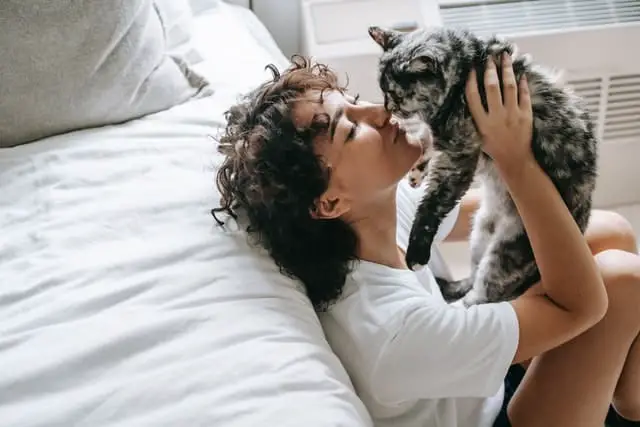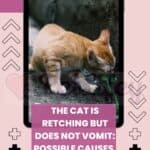
Cats are known to be very complex animals, and they don’t always like to be pampered, unlike dogs. But how do you pamper your cat correctly?
A common belief is that cats don’t like cuddling or being kissed or stroked. Unlike dogs, in fact, the cat is an animal less in need of affection, apparently. But in reality this is not exactly the case. Also, can kissing a cat have some risks for our health or not? There are obviously a number of behaviors that these little furballs might find annoying or even threatening, even if our intentions are the best. So how can we make our cat understand that we want to show him affection, and how can we cuddle the cat in a correct and pleasant way for him / her?
The risks of cat kisses
First of all we should ask ourselves: what are the real risks of kissing our cat? Just as we tend to avoid close contact with humans who are sick, we should avoid kissing our kitty when she / she is sick. The biggest challenge with pets, however, is that we may not always know when they are carrying infections or diseases.
While there are some diseases that we can’t get from our cat (like the flu for example), there are a number of diseases that we risk getting. Zoonotic diseases can in fact be transmitted from animals to humans. These include:
- Common bacteria, such as Pasteurella, Staphylococcus, E-coli and Salmonella, all highly contagious.
- Ringworm, a common fungal infection that is highly contagious and can easily spread from cats to humans. While relatively harmless, it is particularly prevalent in children and can be very frustrating to treat.
- Cat-scratch fever or Bartonella can sometimes be transmitted to humans.
- Parasites, such as toxoplasmosis, can sometimes be transmitted to humans through unsafe contact with the cat’s litter box.
If we know that our dog has one of the diseases listed above, we should be careful to keep our distance until he is well again and avoid cuddling the cat for a while.
A kiss on the lips?
Some say that a cat’s mouth is actually more hygienic than a human’s. It is true that the bacteria in the mouth of these felines are quite similar to those of humans; therefore, at any given moment, a cat’s mouth may not be dirtier than ours. However, cats contain some other bacteria in their mouth, which cause gum disease.
As predators, cats also eat animals and insects that can harbor diseases. For safety, we must therefore avoid kissing the cat on the lips. A kiss on the head is just as affectionate and means a lot less chance of contracting any disease. To ensure our cat’s oral hygiene, however, we may consider brushing his teeth regularly or administering a special mouthwash. Your vet will be able to advise us on the best ways to do this and the products to use (obviously not human toothpaste and mouthwash).
If we have a healthy immune system and our cat is free from diseases and parasites, giving our furry friend a quick kiss will likely have very little risk. However, there are a number of people for whom contact with animals can pose a great risk. People who should avoid close contact with cats include:
- Very young children
- Pregnant women
- Immunocompromised people (such as those with HIV, or being treated for cancer)
- People with weak immune systems
If we or a member of our family are in a high-risk category, it is best to seek advice from your doctor.
If our immune system is weak or the cat is sick, we avoid close contact. However, it is worth noting that, in general, having a cat around the house can actually improve our health. Many studies suggest that having a pet improves mood, lowers blood pressure, and strengthens the immune system. The researchers also found that children who grow up with animals have fewer allergies, likely due to early exposure to various bacteria and viruses.
But do cats like being kissed?
Cats like to behave aloof, but research shows that they truly love their human owners. Except the ways they express their love are different from what we’re used to – but that just means it’s something we can learn. Are there better ways to show our affection for your cat?
It probably shouldn’t surprise us to know that cats can be unsure of when, where and what kind of affection they get. While some cats seem to like them and require human kisses, others surely don’t like them. It is likely that we already know very well which side our cat is on, between the two.
The liking or dislike of a cat towards our affection can obviously also change from day to day (or from hour to hour). The same cat who loves to be cuddled in the morning, in the evening such attentions could blow and give signs of intolerance: these furballs can be moody creatures, but learning to speak their language can go a long way in learning how to handle cat cuddles, and to understand them a little better.
Physical behavior
To begin with, cat kisses are very different from what we humans give. If we’ve ever noticed that when your cat is relaxed and happy, he slowly closes his eyes as he looks at us, then we should know that he’s actually not just sleeping. He is actually blowing us a real kiss! When cats close their eyes towards us they are warning us that for us they are vulnerable: and if it is not this love …
Once again, we need to know the particular signs of our cat to understand what they mean: the half-closed eyes and the ears folded at half mast, do not show love or affection, on the contrary. At that moment, the cat doesn’t want to be bothered even for a cuddle.
How to cuddle the cat, then?
To really understand why our furry dogs have these moody behaviors when it comes to affection (and not only that, to be honest), we first need to know a little more about their ancestors. It is likely that the ancestors of the domestic cat (the African wild cat) were considered a mere guard animal for parasites, but today’s cats are often treated as our precious companions or even “fur babies”.
This social shift in the human-cat relationship is believed to have occurred about 4,000 years ago, a little later than the domestic dog. While this may seem like enough time for a species to fully adjust to growing social needs, this is unlikely to be the case for our mustache friend. Domestic cats also exhibit relatively minimal genetic divergence from their ancestors, meaning their brains are likely still programmed to think like a feral cat. Wild cats they live a lonely life and invest a lot of time and effort in communicating indirectly – through visual and chemical messages – just to avoid seeing each other. So domestic cats are unlikely to have inherited many complex social skills from their relatives.
Humans, on the other hand, are an inherently social species, favoring closeness and contact during displays of affection. We’re also attracted to childish-looking elements (big eyes and forehead, small nose and round face) – that’s why most of us find cat faces so cute. It is therefore not surprising that our initial reaction when we see a cat or even more a kitten is to want to pet and cuddle them. Although it shouldn’t surprise us that many cats find this type of interaction a little overwhelming.
Although many cats enjoy being petted, and in certain contexts they will even choose us over food, human interaction is something they must learn to enjoy during their relatively short sensitive period, between two and seven weeks of life. When it comes to human-cat interactions, human characteristics are also important. Our personalities and gender, the regions of the cat’s body that we touch and the way we generally handle our pets, can all play an important role in how the cat will respond to our affective gestures.
And while some cats may react aggressively to unwanted physical attention, others may simply tolerate our social progress in exchange for good things (food and shelter). That said, a tolerant cat isn’t necessarily a happy cat. Higher stress levels are reported in cats who are described by their owners as being tolerant of stroking rather than just not wanting to know.
How to stroke a cat

The key to success is to focus on providing the cat with maximum choice and control during possible interactions. For example, the choice of indicating whether they want to be caressed or not, and controlling where we touch them and for how long. But this self-control work could pay off a lot in the long run, because research shows that interactions with cats last longer when the cat, rather than the human, initiates them.
It is also very important to pay attention to your cat’s behavior and posture during interactions to make sure she is comfortable. When it comes to touching these pets, it’s always best to keep yourself as small as possible. As a general guideline, friendliest cats will enjoy being touched in regions where their facial glands are located, including the base of the ears, under the chin, and around the cheeks. These locations are generally preferred over areas such as the belly, back, and base of the tail.
Signs of enjoyment of cats:
- Tail held upright, and the choice to initiate contact.
- Purring and touching us repeatedly with the front paws.
- Gently wave the tail from side to side while holding it in the air.
- Relaxed posture and facial expression, ears straight and facing forward.
- It gives us a slight nudge if we stop while we stroke them.
Signs of dislike or tension:
- It dodges us, moves or moves its head away from us.
- Remains passive (no purring or rubbing).
- Excessive blinking, shaking of the head or body, or licking the nose.
- Quick and short licks to the hair as if to wash.
- Wrinkled or contracted skin, usually along the back.
- Tail that squirts, beats or wags.
- Ears that flatten to the sides or rotate backwards.
- An abrupt turn of the head, to face us or our hand.
- It bites, rubs or hits our hand with its paw.






